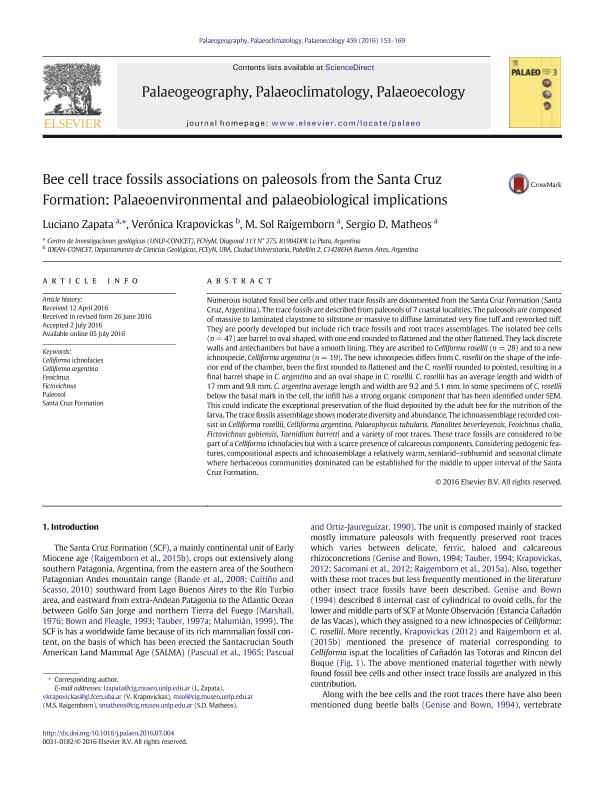Artículo
Bee cell trace fossils associations on paleosols from the Santa Cruz Formation: Palaeoenvironmental and palaeobiological implications
Fecha de publicación:
10/2016
Editorial:
Elsevier Science
Revista:
Palaeogeography, Palaeoclimatology, Palaeoecology
ISSN:
0031-0182
Idioma:
Inglés
Tipo de recurso:
Artículo publicado
Clasificación temática:
Resumen
Numerous isolated fossil bee cells and other trace fossils are documented from the Santa Cruz Formation (Santa Cruz, Argentina). The trace fossils are described from paleosols of 7 coastal localities. The paleosols are composed of massive to laminated claystone to siltstone or massive to diffuse laminated very fine tuff and reworked tuff. They are poorly developed but include rich trace fossils and root traces assemblages. The isolated bee cells (n = 47) are barrel to oval shaped, with one end rounded to flattened and the other flattened. They lack discrete walls and antechambers but have a smooth lining. They are ascribed to Celliforma rosellii (n = 28) and to a new ichnospecie, Celliforma argentina (n = 19). The new ichnospecies differs from C. rosellii on the shape of the inferior end of the chamber, been the first rounded to flattened and the C. rosellii rounded to pointed, resulting in a final barrel shape in C. argentina and an oval shape in C. rosellii. C. rosellii has an average length and width of 17 mm and 9.8 mm. C. argentina average length and width are 9.2 and 5.1 mm. In some specimens of C. rosellii below the basal mark in the cell, the infill has a strong organic component that has been identified under SEM. This could indicate the exceptional preservation of the fluid deposited by the adult bee for the nutrition of the larva. The trace fossils assemblage shows moderate diversity and abundance. The ichnoassemblage recorded consist in Celliforma rosellii, Celliforma argentina, Palaeophycus tubularis, Planolites beverleyensis, Feoichnus challa, Fictovichnus gobiensis, Taenidium barretti and a variety of root traces. These trace fossils are considered to be part of a Celliforma ichnofacies but with a scarce presence of calcareous components. Considering pedogenic features, compositional aspects and ichnoasemblage a relatively warm, semiarid–subhumid and seasonal climate where herbaceous communities dominated can be established for the middle to upper interval of the Santa Cruz Formation.
Archivos asociados
Licencia
Identificadores
Colecciones
Articulos(CIG)
Articulos de CENTRO DE INVEST.GEOLOGICAS (I)
Articulos de CENTRO DE INVEST.GEOLOGICAS (I)
Citación
Zapata, Luciano; Krapovickas, Verónica; Raigemborn, María Sol; Matheos, Sergio Daniel; Bee cell trace fossils associations on paleosols from the Santa Cruz Formation: Palaeoenvironmental and palaeobiological implications; Elsevier Science; Palaeogeography, Palaeoclimatology, Palaeoecology; 459; 10-2016; 153-169
Compartir
Altmétricas




